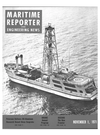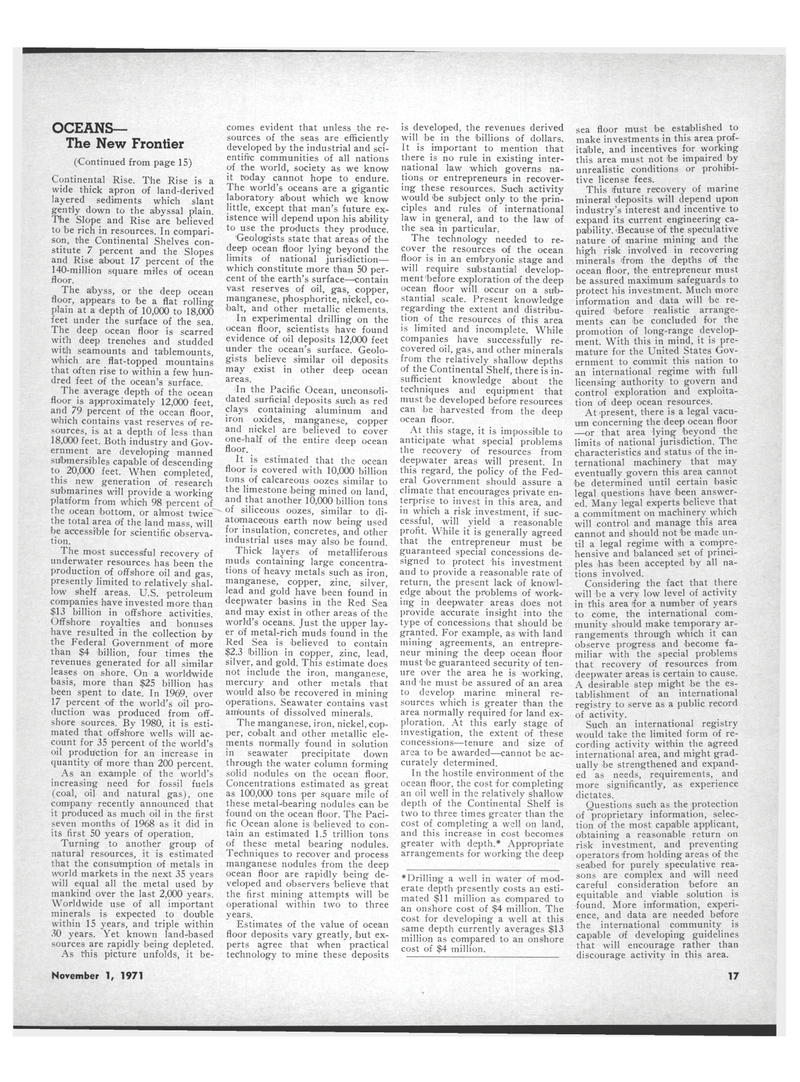
Page 15: of Maritime Reporter Magazine (November 1971)
Read this page in Pdf, Flash or Html5 edition of November 1971 Maritime Reporter Magazine
OCEANS—
The New Frontier (Continued from page 15)
Continental Rise. The Rise is a wide thick apron of land-derived layered sediments which slant gently down to the aibyssal plain.
The Slope and Rise are believed to be rich in resources. In compari- son, the Continental Shelves con- stitute 7 percent and the Slopes and Rise about 17 percent of the 140-million square mi'les oif ocean floor.
The abyss, or the deep ocean floor, appears to be a flat rolling plain at a depth of 10,000 to 18,000 feet under the surface of the sea.
The deep ocean floor is scarred wit'h deep trenches and studded with seamounts and ta'blemounts, which are flat-topped mountains that often rise to within a few hun- dred feet of the ocean's surface.
The average depth of the ocean floor is approximately 12,000 feet, and 79 percent of the ocean floor,
W'hich contains vast reserves of re- sources, is at a depth of less than 18.000 feet. Both industry and Gov- ernment are developing manned submersibles capable of descending to 20,000 feet. When completed, this new generation of research submarines will provide a working platform from which 98 percent of the ocean bottom, or almost twice the total area of the land mass, will be accessible for scientific observa- tion.
The most successful recovery of underwater resources has been the production of offshore oil and gas, presently limited to relatively shal- low shelf areas. U.S. petroleum companies have invested more than $13 billion in offshore activities.
Offshore royalties and bonuses have resulted in the collection by the Federal Government of more than $4 billion, four times the revenues generated for all similar leases on shore. On a worldwide basis, more than $25 billion has been spent to date. In 1969, over 17 percent of the world's oil pro- duction was produced from off- shore sources. By 1980, it is esti- mated that offshore wells will ac- count for 35 percent of the world's oil production for an increase in quantity of more than 200 percent.
As an example of the world's increasing need for fossil fuels (coal, oil and natural gas), one company recently announced that it produced as much oil in the first seven months of 1968 as it did in its first 50 years of operation.
Turning to another group of natural resources, it is estimated that the consumption of metals in world markets in the next 35 years will equal all the metal used by mankind over the last 2,000 years.
Worldwide use of all important minerals is expected to double within 15 years, and triple within 30 years. Yet known land-based sources are rapidly being depleted.
As this picture unfolds, it be- comes evident that unless the re- sources of the seas are efficiently developed by the industrial and sci- entific communities of all nations of the world, society as we know it today cannot hope to endure.
The world's oceans are a gigantic laboratory about which we know little, except that man's future ex- istence will depend upon his ability to use the products they produce.
Geologists state that areas of the deep ocean floor lying beyond the limits of national jurisdiction— which constitute more than 50 per- cent of the earth's surface—contain vast reserves of oil, gas, copper, manganese, phosphorite, nickel, co- balt, and other metallic elements.
In experimental drilling on the ocean floor, scientists have found evidence of oil deposits 12,000 feet under the ocean's surface. Geolo- gists believe similar oil deposits may exist in other deep ocean areas.
In the Pacific Ocean, unconsoli- dated surficial deposits su'ch as red clays containing aluminum and iron oxides, manganese, copper and nickel are believed to cover one-half of the entire deep ocean floor.
It is estimated that the ocean floor is covered with 10,000 billion tons of calcareous oozes similar to the limestone -being mined on land, and that another 10,000 billion tons of siliceous oozes, similar to di- atomaceous earth now being used for insulation, concretes, and other industrial uses may also be found.
Thick layers of metalliferous muds containing large concentra- tions of heavy metals suc'h as iron, manganese, copper, zinc, silver, lead and gold have been found in deepwater basins in the Red Sea and may exist in other areas of the world's oceans. Just the upper lay- er of metal-rich muds found in the
Red Sea is believed to contain $2.3 billion in copper, zinc, lead, silver, and gold. This estimate does not include the iron, manganese, mercury and other metals that would also be recovered in mining operations. Seawater contains vast amounts of dissolved minerals.
The manganese, iron, nickel, cop- per, cobalt and other metallic ele- ments normally found in solution in seawater precipitate down through the water column forming solid nodules on the ocean floor.
Concentrations estimated as great as 100,000 tons per square mile of these metal-bearing nodules can be found on the ocean floor. The Paci- fic Ocean alone is believed to con- tain an estimated 1.5 trillion tons of these metal bearing nodules.
Techniques to recover and process manganese nodules from the deep ocean floor are rapidly being de- veloped and observers believe that the first mining attempts will be operational within two to three years.
Estimates of the value of ocean floor deposits vary greatly, but ex- perts agree that wben practical technology to mine these deposits is developed, the revenues derived will be in the billions of dollars.
It is important to mention that there is no rule in existing inter- national law which governs na- tions or entrepreneurs in recover- ing these resources. Such activity would be subject only to the prin- ciples and rules of international law in general, and to the law of the sea in particular.
The technology needed to re- cover the resources of the ocean floor is in an embryonic stage and will require substantial develop- ment before exploration of the deep ocean floor will occur on a sub- stantial scale. Present knowledge regarding the extent and distribu- tion of the resources of this area is limited and incomplete. While companies have successfully re- covered oil, gas, and other minerals from the relatively shallow depths of the Continental Shelf, there is in- sufficient knowledge about the techniques and equipment that must be developed before resources can be harvested from the deep ocean floor.
At this stage, it is impossible to anticipate what special problems the recovery of resources from deepwater areas will present. In this regard, the policy of the Fed- eral Government should assure a climate that encourages private en- terprise to invest in this area, and in which a risk investment, if suc- cessful, will yield a reasonable profit. While it is generally agreed that the entrepreneur must be guaranteed special concessions de- signed to protect his investment and to provide a reasonable rate of return, the present lack of knowl- edge about the problems of work- ing in deepwater areas does not provide accurate insight into the type of concessions that should be granted. For example, as with land mining agreements, an entrepre- neur mining the deep ocean floor must be guaranteed security of ten- ure over the area he is working, and 'he must be assured of an area to develop marine mineral re- sources which is greater than the area normally required for land ex- ploration. At this early stage of investigation, the extent of these concessions—tenure and size of area to be awarded—cannot be ac- curately determined.
In the hostile environment of the ocean floor, the cost for completing an oil well in the relatively shallow depth of the Continental Shelf is two to three times greater than the cost of completing a well on land, and this increase in cost becomes greater with depth.* Appropriate arrangements for working the deep •Drilling a well in water of mod- erate depth presently costs an esti- mated $11 million as compared to an onshore cost of $4 million. The cost for developing a well at this same depth currently averages $13 million as compared to an onshore cost of $4 million. sea floor must be established to make investments in this area prof- itable, and incentives for working this area must not be impaired by unrealistic conditions or prohibi- tive license fees.
This future recovery of marine mineral deposits will depend upon industry's interest and incentive to expand its current engineering ca- pability. 'Because of the speculative nature of marine mining and the high risk involved in recovering minerals from the depths of the ocean floor, the entrepreneur must be assured maximum safeguards to protect his investment. Much more information and data will be re- quired before realistic arrange- ments can be concluded for the promotion of long-range develop- ment. With this in mind, it is pre- mature for the United States Gov- ernment to commit this nation to an international regime with full licensing authority to govern and control exploration and exploita- tion of deep ocean resources.
At present, there is a legal vacu- um concerning the deep ocean floor —or that area lying beyond the limits of national jurisdiction. The characteristics and status of the in- ternational machinery that may eventually govern this area cannot 'be determined until certain basic legal questions have been answer- ed. Many legal experts believe that a commitment on machinery which will control and manage this area cannot and should not be made un- til a legal regime with a Compre- hensive and balanced set of princi- ples has been accepted by all na- tions involved.
Considering the fact that there will be a very low level of activity in this area for a number of years to come, the international com- munity should make temporary ar- rangements through which it can observe progress and become fa- miliar with the special problems that recovery of resources from deepwater areas is certain to cause.
A desirable step might be the es- tablishment of an international registry to serve as a public record of activity.
Such an international registry would take the limited form of re- cording activity wit'hin the agreed international area, and might grad- ually be strengthened and expand- ed as needs, requirements, and more significantly, as experience dictates.
Questions such as the protection of proprietary information, selec- tion of the most capable applicant, obtaining a reasonable return on risk investment, and preventing operators from holding areas of the seabed for purely speculative rea- sons are complex and will need careful consideration before an equitable and viable solution is found. More information, experi- ence, and data are needed before the international community is capable Of developing guidelines that will encourage rather than discourage activity in this area.
November 1, 1971 17

 14
14

 16
16
